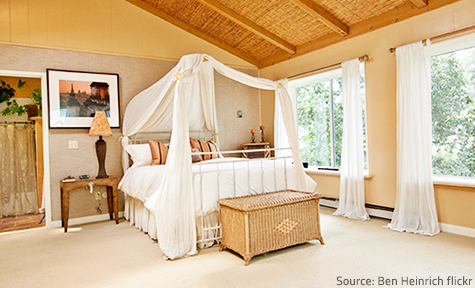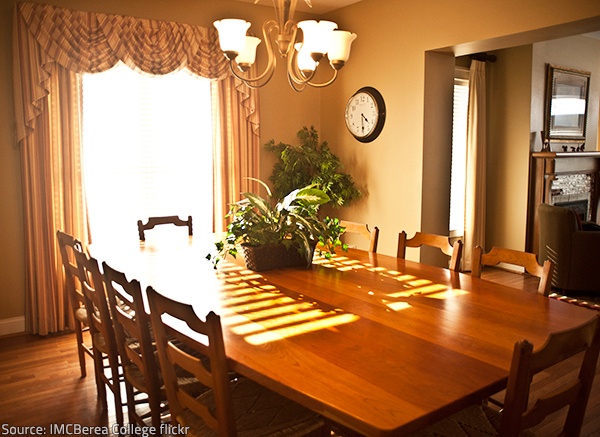Have you ever watched in fascination as the sunrays play amazing tricks on the walls and surfaces in your home? Have you wondered at the beauty and splendor of natural light flowing through your windows at sunrise? Have you noticed how rich and vibrant colors become once lit by the sun. Sunlight adds charm and dynamics to the ambiance, enhances the appearance of everything it touches, and makes a space appear larger and brighter. It’s only natural then that you’ll want to let in as much light as possible and enjoy it for as long as you can.

Natural light brings warmth and color into our lives.
Allowing light into your home, however, has one significant drawback – it can ruin your fine furniture, nice carpeting, and delicate artwork. The UV rays in the sunlight can break down many of the chemicals that exist in furniture and fabric dyes and cause permanent discoloration and fading of wood. To prevent this negative impact of light on your cherished possessions, you need to find an efficient way to protect them from sun fading and deterioration.
Here are some useful ideas you may want to put into practice when it comes to protecting your furniture from sun damage.
How to Prevent Furniture from Fading
In order to prevent color fading and preserve the fabulous look and feel of your furniture for many years, you need to take adequate protective measures against the harmful effect of the sun.
Protect Furniture from Sunlight
To prevent sun damage to your furniture, you’re recommended to:
- Keep your pieces away from direct sunlight – Place your furniture items, especially the more delicate and valuable ones, in shaded areas of the room, away from windows and skylights. If necessary, consider rearranging your rooms so that your most vulnerable pieces are not exposed to direct light;
- Use window treatments – Hang curtains and draperies, close blinds and shutters, or use shades and awnings to block out the sun, especially when it is particularly strong (during the hot summer months, on the afternoons, etc.);
- Apply window film – Window films are your best bet for dealing with sun and light issues in your home. High quality solar window films reflect up to 99.9 percent of the sun’s UV rays. They are installed on the inside of your windows (preferably, by a professional) to create a protective layer that filters out the harmful rays without restricting your view. You can keep the curtains open and enjoy the natural light with no risk of damage to your furnishings. As an added bonus, window tints reduce the heat in your home and help save on energy bills;
- Installing new windows – Modern windows are especially designed to block UV rays (they filter about 85 percent of the harmful rays) and improve the energy efficiency of your home.
Good to remember: Keep in mind that UV rays are present even on cloudy or rainy days when the sun isn’t shining.
Protect Furniture from Fading

Intense sunlight can cause your cherished furniture to fade and deteriorate over time.
In addition to preventing prolonged exposure to sunlight, you may also want to consider providing some kind of coating to protect the delicate furniture surface.
1) Seal wood furniture
Sealants not only protect the wood from sunlight, heat, and water, but can also greatly enhance the beauty of the grain. You have several options, depending on the type of the wood and the severity of the exposure:
- Varnish seals the wood fibers and provides excellent protection against ultraviolet light and water. It is made from resins, oil and solvents, and comes in a variety of different finishes;
- Lacquer creates a hard shell over the furniture surface and provides it with a durable, long-lasting protection. It is not recommended for coarse grain woods, such as oak, or very soft woods, such as cedar;
- Polyurethane is also very durable and long-lasting but can be susceptible to cracking under intense heat;
- Shellac is a natural product that brings out the richness of wood grains and looks very attractive on walnut, mahogany, and fine veneer woods. However, it isn’t very durable and offers only average resistance to sunlight and general wear, so it is usually used for decorative pieces that don’t see much daily use;
- Wax and oil finishes also enhance the appearance of wood furniture but require more regular upkeep and are less durable than other types of wood sealants.
2) Protect fabric upholstery
Most fabrics are highly susceptible to fading from the sun, especially high-end materials such as linen and silk (materials blended with acrylic, polyester, and nylon are less likely to fade). To prevent fabric furniture from discoloration and premature wear, you are advised to spray the pieces with a specialized fabric protector (don’t forget to try the product on a small inconspicuous area first to see if it will work well on your furniture).
Also, make sure you choose lighter colors for the upholstery of furniture pieces that are likely to sit in the sun, as lighter fabrics show less fading than darker ones.
3) Condition leather
When leather pieces are exposed to direct sunlight, the leather’s natural oil evaporates. As a result, the colors fade (the darker the color, the more quickly and easily the leather will fade) and the leather stiffens and cracks. Conditioning the leather can help prevent drying and discoloration – just make sure you use an appropriate leather conditioner and apply it at least twice a year.

Are you up for a game of hide and seek with the sun?
If, despite your best efforts, your cherished furniture fades with time, this still doesn’t mean that you need to give up on it. Sun fading can actually make the piece even more appealing as sunlight brings an attractive mellowness that adds to the antique feel of the furniture. And even if this is not the case and the severe or uneven fading makes your piece appear damaged rather than aged, you can still save it and make it look like new – all you need to do is follow the simple, yet highly effective steps for restoring sun faded furniture listed below.
How to Restore Faded Wood Furniture
Depending on the severity of the damage and the condition of the wood finish, you have two viable options for restoring faded wood furniture:
Oil Treatment
If the fading is slight and the finish has been rendered porous from microscopic cracks caused by ultraviolet rays, applying wood oil may be all that is necessary to restore the original color of the furniture. This method usually works well on mahoganies and walnuts, but should be avoided on cherry, rosewood, and other fine woods with inherent variegated streaks.
To find out if oil treatment will do the trick for you, apply several drops of oil on an edge or another inconspicuous spot of your sun faded furniture. Rub in the oil and wait for some time to see if the color will break through and if it will match the unaffected areas of the piece.
If the result is satisfactory, apply a thin film of the oil over the entire damaged surface and rub along the grain with grade 400 abrasive paper. When the color is restored, provide a suitable protective coating.
If the oil treatment fails, you have no choice but to strip and refinish your faded furniture piece.
Wood Refinishing
When the fading is severe, the finish has to be removed and the bleached wood sanded far enough to reveal the natural color. Then the surface should be stained or oiled before finally sealing the wood.
- Set up an appropriate workspace – Choose a well-ventilated, clean area of your property where there will be no risk of dust, dirt, or debris getting stuck in the new finish. Make sure you protect the items and surfaces in your work area with drop cloths before you get started;

You can easily bring your faded wood furniture back to life.
- Clean the furniture – Wipe down the furniture with a moist cloth to remove any accumulated dirt and grime (it may be a good idea to dampen the cloth in a solution of white vinegar and water for better results). Allow the furniture to dry fully before getting down to work;
- Strip the finish – Use a specialized chemical agent or sand the surface to fully strip the wood of sealants, paints, and/or stains. Have in mind though that if you’re dealing with an antique or vintage item, stripping the original finish is not a good idea as it may lessen or void the value of your piece (an item that has experienced more than 50 percent change in its original character is no longer considered an antique). In this case, you’re strongly advised to leave the refinishing work to a professional who has the specialized equipment and extensive experience required to successfully complete the project – the experts will not only restore the original color and beauty of your antique piece, but will also preserve as much of its original finish as possible;
- Even the surface – Inspect the stripped surface to make sure that there are no rough patches, splinters, cracks, or other uneven texture on the wood. If necessary, sand the surface until it is perfectly smooth;
- Apply an appropriate paint or stain – Use a product that is specifically designed for the type of wood of your furniture. Work carefully and strictly follow the directions on the package;
- Seal the wood – Apply an appropriate sealant to give your furniture the type of look you want and to provide it with efficient protection against sun damage. This last step will ensure that your piece remains in excellent condition for a long time.
If you’re not sure what kind of refinishing products to use or if you don’t have the time or the patience required to complete the project in an efficient manner, your best bet is to hire professional furniture refinishing services. You will save yourself a lot of time and effort and will remain delighted by the astounding results.












